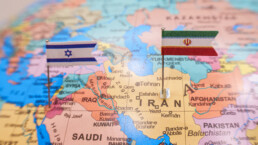Iran’s retaliatory strikes on Israel highlight an America-led regional war spanning Iraq, Jordan, Saudi Arabia, and others.
By Ken Klippenstein and Daniel Boguslaw, The Intercept
The regional war in the Middle East now involves at least 16 different countries and includes the first strikes from Iranian territory on Israel, but the United States continues to insist that there is no broader war, hiding the extent of American military involvement. And yet in response to Iran’s drone and missile attacks Saturday, the U.S. flew aircraft and launched air defense missiles from at least eight countries, while Iran and its proxies fired weapons from Iraq, Syria, and Yemen.

The news media has been complicit in its portrayal of the regional war as nonexistent. “Biden Seeks to Head Off Escalation After Israel’s Successful Defense,” the New York Times blared this morning, ignoring that the conflict had already spread. “Iran attacks Israel, risking a full-blown regional war,” says The Economist. “Some top U.S. officials are worried that Israel may respond hastily to Iran’s unprecedented drone and missile attacks and provoke a wider regional conflict that the U.S. could get dragged into,” says NBC, parroting the White House’s deception.
The Washington-based reporting follows repeated Biden administration statements that none of this amounts to a regional war. “So far, there is not … a wider regional conflict,” Pentagon press secretary Brig. Gen. Pat Ryder said on Thursday, in response to a question about Israel’s strike on the Iranian Embassy. Ryder’s statement followed repeated assertions by Iranian leadership that retaliation would follow — and even a private message from the Iranians to the U.S. that if it helped defend Israel, the U.S. would also be a viable target — after which the White House reiterated its “ironclad” support for Israel.
Recent Posts
‘Unconstitutional. Unethical. Authoritarian.’ ICE Bars Millions Of Immigrants From Bond Hearings
July 18, 2025
Take Action Now One watchdog said the new policy “seems like a blatant attempt to stop them from exercising their right to due process.”……
Americans Are Not Nearly Alarmed Enough About Climate Change
July 18, 2025
Take Action Now Americans still don’t comprehend how imminent, dangerous, and far-reaching the threat is—and journalists are partly to blame.By…
The IRS Is Building A Vast System To Share Millions Of Taxpayers’ Data With ICE
July 17, 2025
Take Action Now ProPublica has obtained the blueprint for the Trump administration’s unprecedented plan to turn over IRS records to Homeland Security…
Israel’s Sudden Assault On Syria Is Unchecked Aggression
July 17, 2025
Take Action Now Jerusalem is bombing Damascus and threatening al-Sharaa’s rule, while Washington was hoping to help the nascent government on…




